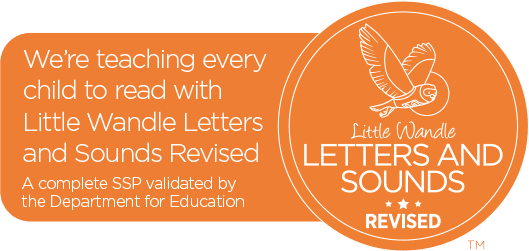Phonics Support for Families
Phonics
At Ivy Bank Primary School, we teach Phonics through a scheme called Little Wandle Letters and Sounds Revised. This is a complete systematic synthetic phonics programme (SSP) developed for schools by schools. It is based on the original Letters and Sounds, but has been extensively revised to provide a complete teaching programme which meets all the expectations of the National Curriculum.
In phonics, we teach children that the letters of the alphabet represent a different sound, that these can be used in a variety of combinations and are put together to make words. The children learn to recognise all of the different sounds and combinations that they might see when they are reading or writing
Phonics is taught daily for children working at Phases 1 - 5, and from Phase 2, these children have an additional 3 reading practise sessions per week, to help build fluency in decoding.
Click Here to access the 'Parents' section of the Little Wandle website where you will find more information about how to support your child with phonics at home. Here you will find the Reception and Year One overview as well as videos of the sound pronunciations, letter formation sheets and other helpful resources.
Reading Practice Sessions
Children across Reception, Year 1, Year 2 (and beyond if appropriate) apply their phonics knowledge by using a full matched decodable reader in a small group reading practice session.
Your child will bring home a reading practice book that is matched to their phonic ability and they will read 3 times across the week focusing on different skills:
Decoding - applying their phonics skills to reading
Prosody - reading with expression and intonation
Comprehension - answering different questions about the text e.g. inference, prediction etc.
The aim is that your child reads with 95% fluency as the book is fully decodable. This means that the children should not be reading books that include sounds they have not learnt during phonics lessons. Your child should be able to read the book without any significant support. If they are reading fluently, this is the appropriate book and is not too easy for them.
Phonics Screening Check
Towards the end of Year 1, every child undergoes the Phonic Screening test, which is a national assessment initiated by the Government. It is designed to give teachers and parents information on how your child is progressing in phonics. It will help to identify whether your child needs additional support at this stage so that they do not fall behind in this vital early reading skill. There are two sections in this 40-word check, half real words and half nonsense words, the nonsense words will be shown to your child with a picture of an alien. If your child does not pass the phonics check in year, they will re-sit this in year 2.
Recommended Resources
Click on the links below which will take you to the following pages:
Reading Eggs Your child has access to Reading Eggs through their Wonde card.
Glossary for Phonics
Alternative spelling - a phoneme can have several ways of being written down ai, ay, a-e.
Blending - to draw individual sounds together to make a word.
Digraph - one sound represented by two letters ‘sh’ fish.
Graph - one sound represented by one letter ‘c’ cat.
Grapheme - the written representation of sounds (graph, digraph, trigraph or quadgraph).
Phoneme - the speech sound of the letter(s).
Quadgraph - one sound represented by four letters ‘eigh’ eight.
Segmenting - to split up a word into its individual phonemes in order to spell it - c-a-t
Split Digraph - a vowel sound represented by two letters, separated by a consonant:
‘a-e’ tape , ‘e-e’ Pete, ‘ i-e’ kite, ‘o-e’ note, ‘u-e’ cube or June
Syllable - a beat in a word that contains a vowel ‘win/dow’
Trigraph - one sound represented by three letters ‘igh’ light
Phonic Phases
Phase 1
Young children learn to discriminate between different sounds in the world around them eg. a dog barking, a telephone ringing.
Phase 2
the children are introduced to letters (graphemes) and corresponding sounds (phonemes) for the first time. Through Phase 2, the children are taught how to segment and blend different sounds to support earkly reading and writing skills eg c-a-t -cat. Below are the sounds taught in Phase 2.
Phase 3
The sound mat below identifies the different graphemes and corresponding graphemes taught in Phase 3. In this phase digraphs and trigraphs (groups of letters making one sound) are introduced eg. c-ar -car.
Phase 4
No new graphemes and phonemes are introduced.Instead, the children have the opportunity to further manipulate those already taught. Polysyllabic words (words containing more than one syllable) are explored as the children learn how to segment and blend an increasing number of sounds together.
Phase 5
New graphemes are introduced, some of which represent phonemes already taught. For example, in Phase 3 'ai' (as in 'rain') is taught, whilst in Phase 5, the children are introduced to 'ay' (as in 'day') as variations in the English language.


